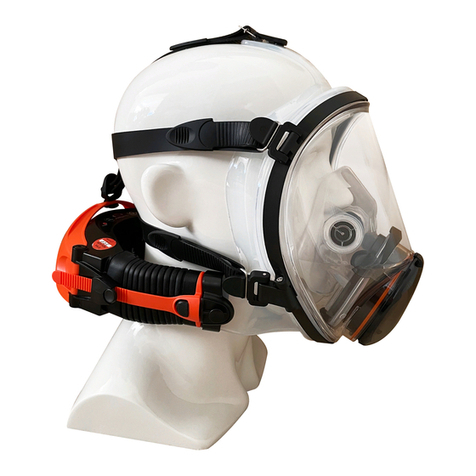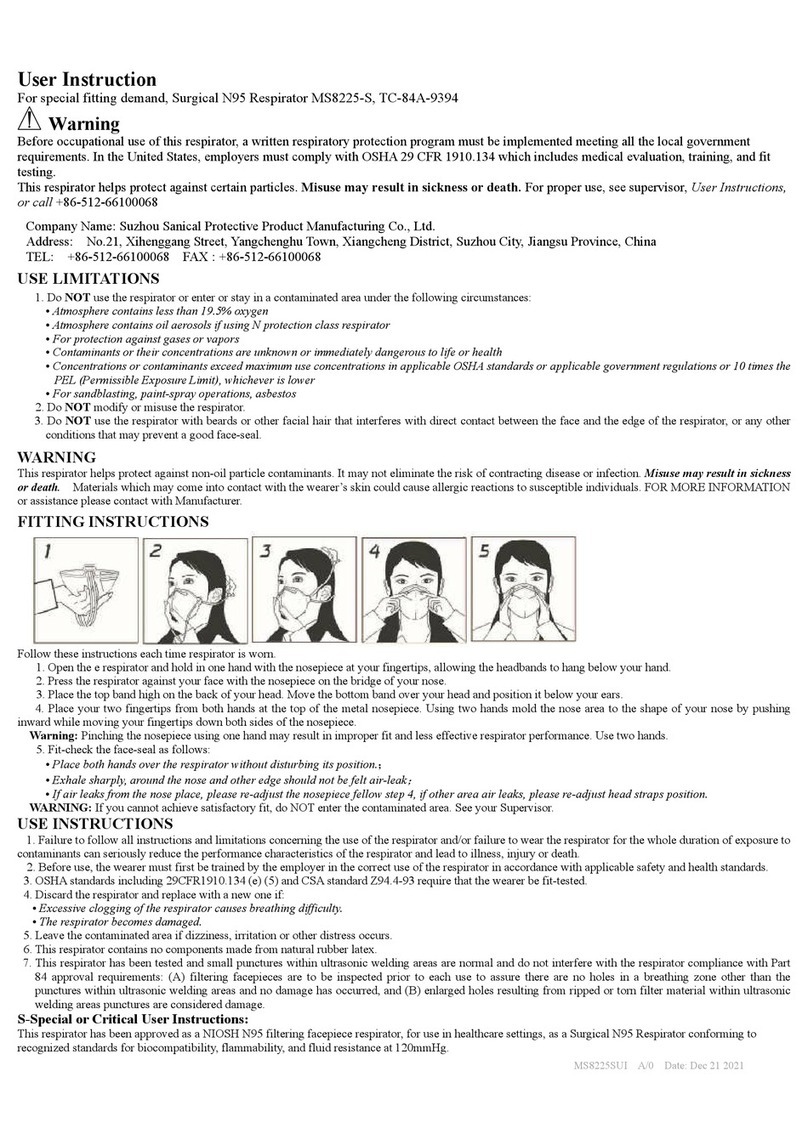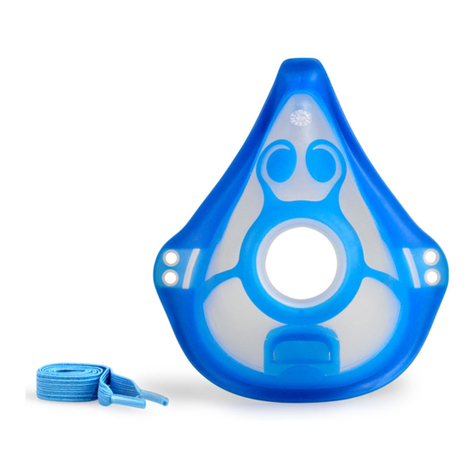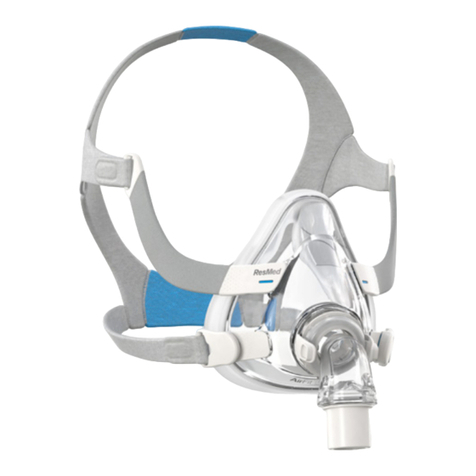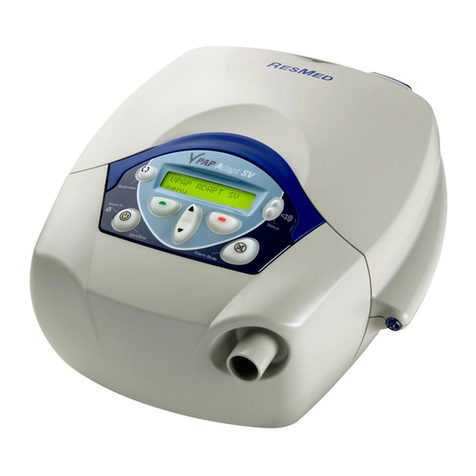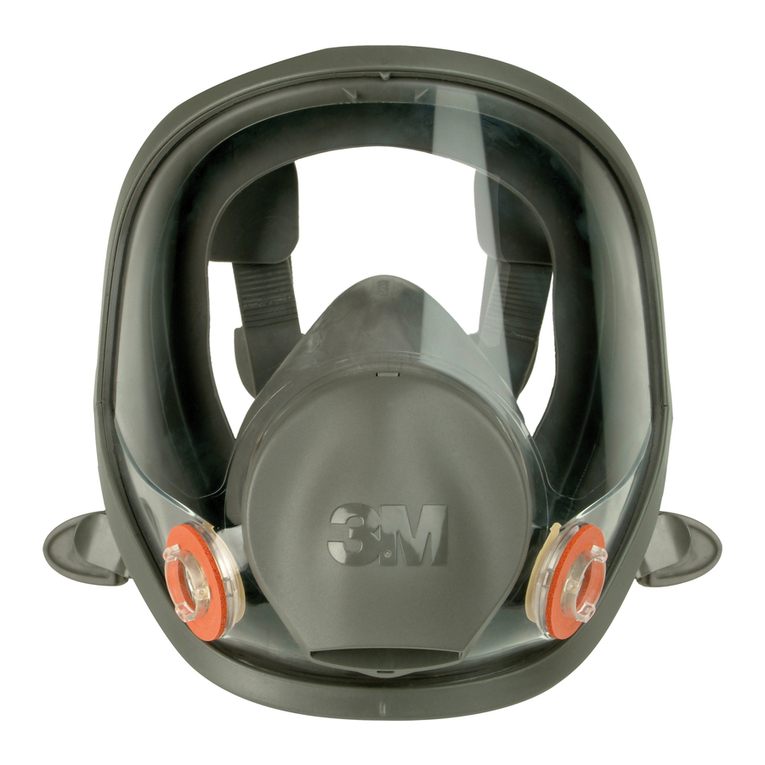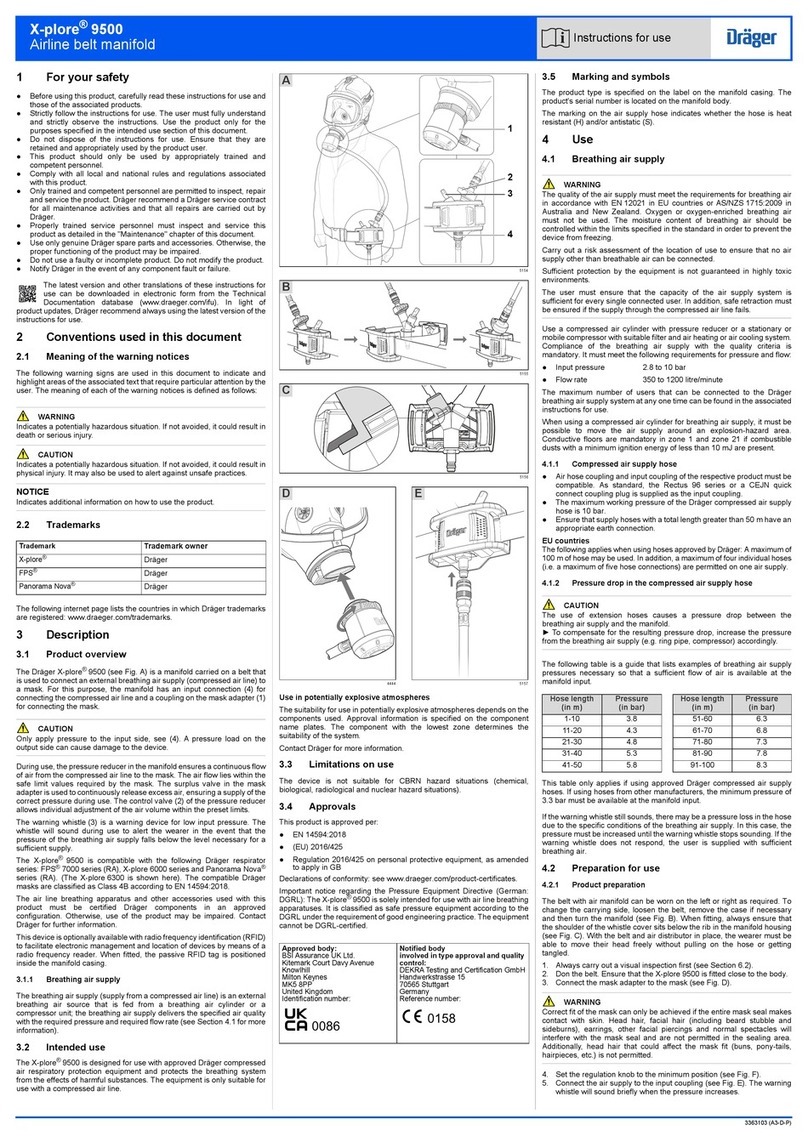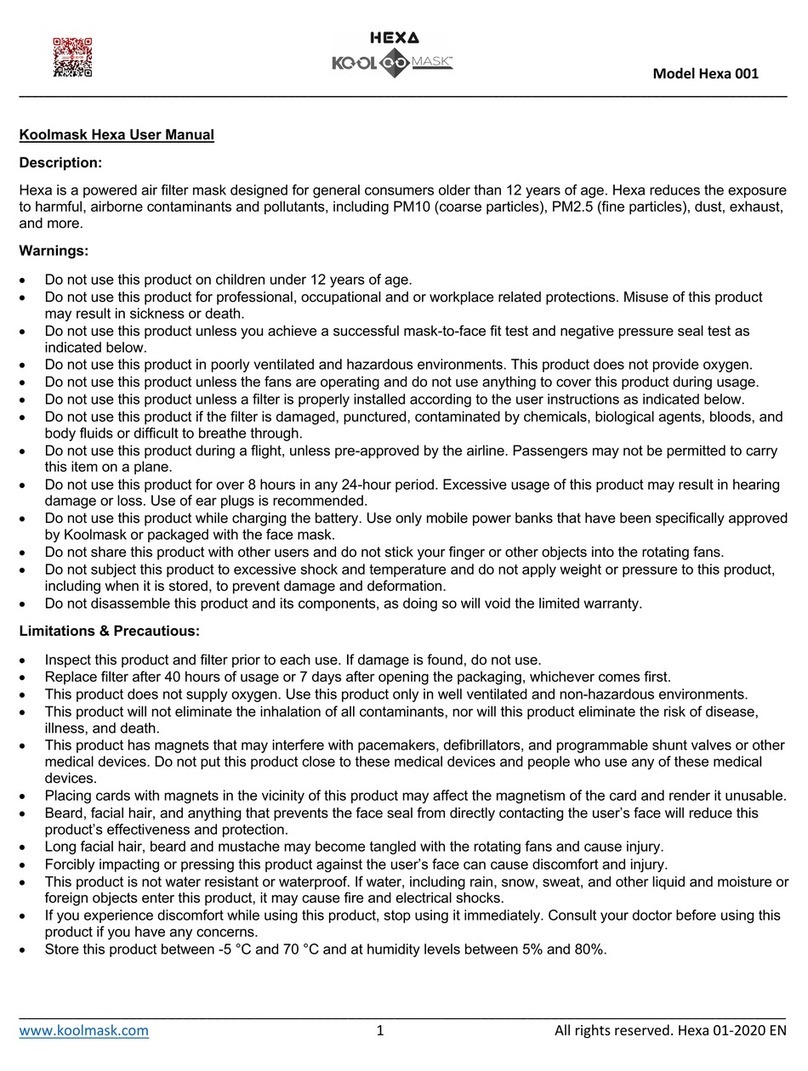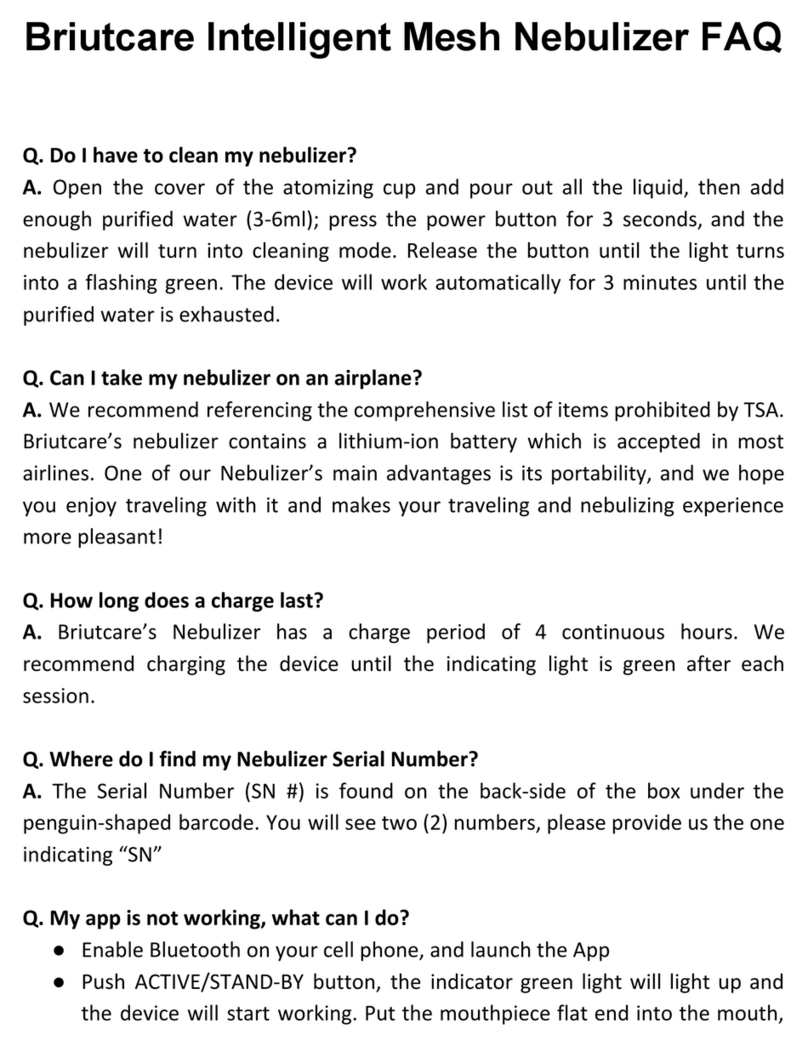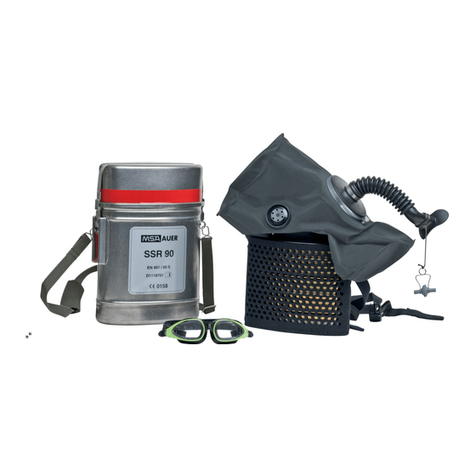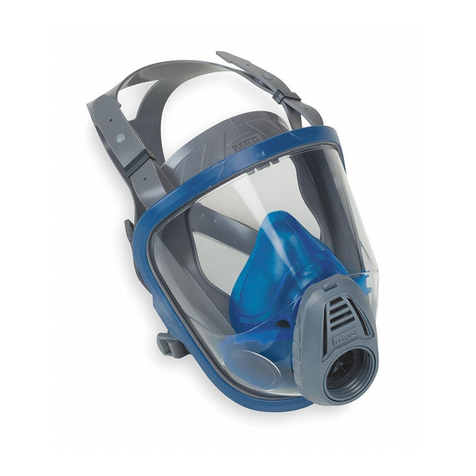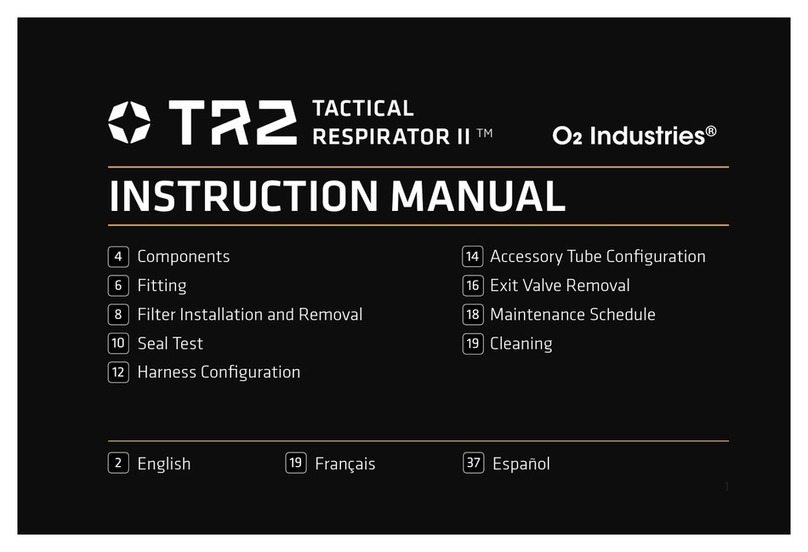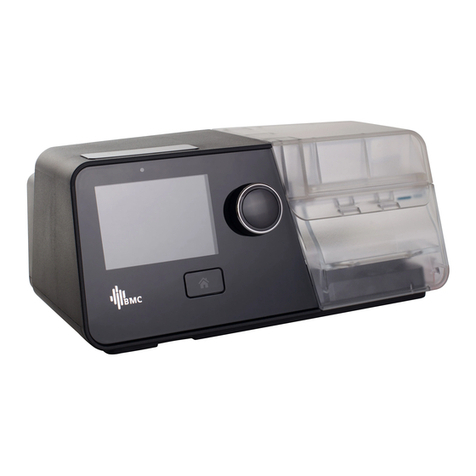CleanSpace CS302 User manual

CS3021
CleanSpace HALO
USA - ENGLISH
CleanSpace Technology Pty Ltd
Unit 5, 39 Herbert Street,
St. Leonards, NSW, 2065,
Australia
USER
www.cleanspacetechnology.com INSTRUCTIONS

2
1. Contents
1.
Contents ............................................................................................................................................................... 2
2.
Foreword .............................................................................................................................................................. 3
3.
System Description .............................................................................................................................................. 3
4.
List of Warnings within these User Instructions ................................................................................................... 3
5.
NIOSH – Approval, Cautions and Limitations ..................................................................................................... 5
6.
S - Special or Critical User Instructions ............................................................................................................... 5
7.
Limitations of Use ................................................................................................................................................ 6
8.
Respirator Program Management ....................................................................................................................... 7
9.
System Components............................................................................................................................................ 8
10.
HALO BIO System ............................................................................................................................................... 9
11.
Controls and Indicators ...................................................................................................................................... 10
12.
Mask Fitting ........................................................................................................................................................ 11
13.
Using CleanSpace HALO with HALF MASKS ................................................................................................... 13
14.
Using CleanSpace HALO BIO with the Head Cover ......................................................................................... 21
15.
Using CleanSpace HALO with Full Face Masks ............................................................................................... 23
16.
Entering and Exiting the Contaminated Area .................................................................................................... 28
17.
Working in Noisy Environments ......................................................................................................................... 29
18.
Fitting & Changing the Filter .............................................................................................................................. 29
19.
Battery Information ............................................................................................................................................. 32
20.
Cleaning ............................................................................................................................................................. 34
21.
Periodic Maintenance & Checking ..................................................................................................................... 37
22.
Performing a Quantitative Fit Test ..................................................................................................................... 37
23.
Changing Half Mask Exhalation Valve Covers .................................................................................................. 39
24.
Specifications ..................................................................................................................................................... 40
25.
Product and Accessory information ................................................................................................................... 41
26.
Product Warranty ............................................................................................................................................... 42
Read these instructions in conjunction with the appropriate CleanSpace™ filters and accessories instructions.
Important: Before use, the wearer must read and understand these user instructions. Keep these user
instructions for reference.
WARNING
This product is part of a system that helps protect against certain airborne contaminants. Misuse may result in
sickness. For proper use, consult an Occupational Health Specialist, these user instructions or contact CleanSpace
Technology Customer Support on [email protected] or the website:
www.cleanspacetechology.com/welcome/

3
2. Foreword
Read all instructions and warnings before using this device. Keep these user instructions for reference. If you have
questions regarding this system contact CleanSpace Customer Service on +612 8436 4000 or e-mail
3. System Description
CleanSpace HALO is a complete NIOSH-approved respiratory system. When used in accordance with its NIOSH
approval, the respirator helps to provide respiratory protection against particulates. HALO does not provide
protection against vapors or gasses and is not an intrinsically safe system. See the NIOSH Approval Section of
these user instructions for additional information on approvals.
The components of the CleanSpace HALO system are shown in Section 9. The blower draws ambient air through
the high efficiency filter and supplies filtered air to the wearer via the mask. HALO is a breath responsive respirator
which means that it blows harder during inhalation and more softly during exhalation. The device continuously
adjusts fan speed to maintain positive pressure in the mask. Should the filter become blocked, an audible alarm will
sound and the “Filter” light on the keypad will be illuminated. If the battery voltage falls below the minimum required
to sustain the designed flow rate, an audible alarm will sound.
The HALO BIO System includes a Head Cover which, in combination with the other HALO BIO components, helps
protect the head and neck from splash contamination. The HALO BIO Head Cover is used with the HALO Half
Masks, HALO BIO Exhalation Valve Cover and HALO BIO filter.
The HALO System includes two optional Exhalation Filters. The Steri-Plus Exhalation Filter Assembly (CS3038 and
CS3039) is used with the Standard Exhalation Valve Cover (PAF-1111) and no head cover. The Exhalation Filter –
HALO BIO (CS3027) is used with both the BIO Exhalation Valve Cover (CS3026) and the HALO BIO head cover.
WARNING
Properly selected, used and maintained respirators help to protect against certain airborne contaminants. It
is essential to follow all instructions and government regulations on the use of this product, including
wearing the complete respirator system during all times of exposure, in order for the product to help protect
the wearer. Misuse of respirators may result in overexposure to contaminants and lead to sickness. For
proper use, consult an Occupational Health Specialist, these user instructions or contact CleanSpace
Technology Customer Support on [email protected] or the website:
www.cleanspacetechology.com/welcome/
4. List of Warnings within these User Instructions
No Half Mask or Full Facepiece PAPR can fully protect you if you are not clean shaven. CleanSpace HALO is not
suitable for users with facial hair.
WARNING
This product is part of a system that helps protect against certain airborne contaminants. Misuse may result in
sickness. For proper use, consult an Occupational Health Specialist, these user instructions or contact CleanSpace
Technology Customer Support on [email protected] or the website:
www.cleanspacetechology.com/welcome/
WARNING
Properly selected, used and maintained respirators help to protect against certain airborne contaminants. It is
essential to follow all instructions and government regulations on the use of this product, including wearing the
complete respirator system during all times of exposure, in order for the product to help protect the wearer. Misuse of
respirators may result in overexposure to contaminants and lead to sickness. For proper use, consult an Occupational
Health Specialist, these user instructions or contact CleanSpace Technology Customer Support on

4
If a satisfactory quantitative fit factor (above 1000) or passing qualitative test cannot be achieved with any of the
masks, CleanSpace HALO must not be used.
Do not use compressed air or a brush to clean the filter! HEPA filters are very easily damaged by the use of
compressed air or by brushing. Misuse of CleanSpace HALO by cleaning the filter may result in overexposure to
contaminants and lead to sickness.
If a satisfactory Seal Check cannot be achieved, do not enter the contaminated zone.
Be sure to remove the Seal Check Cap (Half Mask variants) before entering the contaminated area. The Cap blocks
the exhalation valve, making it more difficult for your exhaled air to be expelled from the mask. Failure to remove the
cap will lead to build-up of Carbon Dioxide in the mask, and may result in headache or dizziness. Never leave the
Cap in place for more than 2 minutes!
Do not leave the seal check cap in place for more than 2 minutes.
If you cannot adjust the mask to avoid your hairline, the mask is not suitable for you and must not be worn.
Do not remove the respirator until you have vacated the contaminated area unless you have pressing health reasons
to do so (for instance you are experiencing dizziness and believe removing the respirator while you leave the
contaminated area may help).
It is essential that the correct filter type is selected for the chosen application.
If the blocked filter alarm is triggered (2 beeps, repeated every second, red LED flashes), leave the contaminated
area immediately and replace the filter. Operating the respirator after the blocked filter alarm has sounded can cause
the flow to fall below the manufacturer’s minimum designed flow, which may result in overexposure to contaminants
and lead to sickness.
When fitting a new filter, the blocked filter alarm shall be tested before the respirator is put back into service. See the
heading “Testing the Blocked Filter Alarm” below.
CleanSpace HALO is not intrinsically safe. Do not use in flammable or explosive atmospheres. Doing so may result
in injury or death.
Always correctly use and maintain the internal lithium ion battery packs. Failure to do so may result in fire or
explosion or could adversely affect respirator performance and result in injury, sickness or death. Do not charge the
on-board battery with unapproved chargers, in enclosed cabinets without ventilation, near flammable liquids or
gasses, or near sources of high heat. Do not immerse the device in water. Do not use, charge or store the device
outside the recommended temperature limits.
If the battery alarm sounds (3 beeps, repeated every second), leave the contaminated area immediately and re-
charge the battery. Operating the respirator after the low battery alarm has sounded can cause the flow to fall below
the manufacturer’s minimum designed flow, which may result in overexposure to contaminants and lead to sickness.
In the extremely rare circumstance that the battery is damaged and electrolyte comes in contact with eyes, flush with
water immediately and seek urgent medical attention.
The Steri-Plus and HALO BIO Exhalation Filters (CS3039 and CS3027 respectively) are electrostatic filters and their
performance will be degraded by exposure to certain organic solvents including isopropanol (IPA), xylene and
toluene. Always remove the Exhalation Filter before cleaning the mask. If there is a possibility that the Exhalation
Filter has become contaminated with any solvent, replace it.
Never dry the mask or exhalation valve with a cloth that may leave behind lint. Lint contamination of the exhalation
valve may cause it to leak, resulting in overexposure to contaminants and lead to sickness.

5
Using a full face mask with the rain cover raised can cause the exhalation valve to vibrate, which you may notice as a
buzzing noise. Lower the rain cover for correct operation.
The blower contains a battery, sensitive electronics and a motor. Never immerse it in water or use anything wetter
than a damp cloth to clean it.
You must recalibrate the internal pressure sensor any time that your CleanSpace HALO is exposed to changes in
temperature of more than 20°C. It is best practice to also re-calibrate if the unit has been in storage, particularly if the
storage temperature is not known.
To check that the test port plug is fitted correctly (after using the on-board fit test ports), a negative pressure Seal
Check shall be performed – see page 25.
5. NIOSH – Approval, Cautions and Limitations
NIOSH APPROVAL
CleanSpace HALO is a NIOSH-approved respirator system. Refer to these User Instructions and to the NIOSH
approval label provided with each CleanSpace HALO for a listing of components that can be used to form a NIOSH-
approved respirator.
NIOSH CAUTIONS AND LIMITATIONS
A - Not for use in atmospheres containing less than 19.5 percent oxygen.
B - Not for use in atmospheres immediately dangerous to life or health.
C - Do not exceed maximum use concentrations established by regulatory standards.
F - Do not use powered air-purifying respirators if airflow is less than four cfm (115 lpm) for tight fitting facepieces or
six cfm (170 lpm) for hoods and/or helmets.
I – Contains electrical parts that may cause an ignition in flammable or explosive atmospheres.
J - Failure to properly use and maintain this product could result in injury or death.
L - Follow the manufacturer's User's Instructions for changing cartridges, canister and/or filters.
M - All approved respirators shall be selected, fitted, used, and maintained in accordance with MSHA, OSHA, and
other applicable regulations.
N - Never substitute, modify, add, or omit parts. Use only exact replacement parts in the configuration as specified
by the manufacturer.
O - Refer to User's Instructions, and/or maintenance manuals for information on use and maintenance of these
respirators.
P - NIOSH does not evaluate respirators for use as surgical masks.
S - Special or critical User's Instructions and/or specific use limitations apply. Refer to User's Instructions before
donning.
6. S - Special or Critical User Instructions
This respirator contains a system for synchronizing with your breathing and regulating mask pressure. This system
requires re-calibration whenever it experiences a change in temperature of more than 36°F (20°C). It is best
practice to also re-calibrate if the unit has been in storage, particularly if the storage temperature is not
known.
For the most accurate battery charge indication, the respirator must be plugged into its charger. To be sure it is fully
charged, plug in the charger and wait for all 3 LEDs to light solidly without flashing. If the 3rd LED is flashing
rapidly, the battery is 95% charged.
The CS3024 Head Cover shall only be used in combination with a HALO Half Mask configured with the HALO BIO
Exhalation Valve Cover, and with the CS3025 Filter HE – HALO BIO. No other combination of mask and filter is
approved for use with the HALO BIO Head Cover. Note: The HALO BIO is a tight-fitting half mask PAPR. The head
cover does not provide or contribute to the system’s respiratory protection.

6
The HALO half masks are approved and may be used without the Head Cover with either the HE Filter HALO BIO
(CS3025) or the HALO Standard HE Filter (CS3022). When configured with either of these filters, the HALO half
masks are approved and may be used with either the Standard Exhalation Valve Cover or the BIO Exhalation Valve
Cover.
The CS3038 Steri-Plus Exhalation Filter Case and the CS3039 Steri-Plus Exhalation Filter shall only be used in
combination with a HALO Half Mask fitted with the PAF-1111 Standard Exhalation Valve Cover. The Steri-Plus
Exhalation Filter shall NOT be used with the Head Cover. Note: The HALO Exhalation Filter does not provide or
contribute to the system’s respiratory protection. An HE Filter (CS3022 or CS3025) must be used.
The CS3027 HALO BIO Exhalation Filter shall only be used in combination with a HALO Half Mask fitted with the
CS3026 HALO BIO Exhalation Valve Cover. The HALO BIO Exhalation Filter can be used with or without the Head
Cover. Note: The HALO BIO Exhalation Filter does not provide or contribute to the system’s respiratory protection.
An HE Filter (CS3022 or CS3025) must be used.
Ensure that either the Standard Exhalation Valve Cover or BIO Exhalation Valve Cover (as applicable for the
intended configuration) is installed prior to use.
7. Limitations of Use
Use this Respirator strictly in accordance with all instructions in these user instructions and NIOSH Approval Labels.
Never modify or alter this product.
Do not remove the Respirator until you have left the contaminated area,
unless you have pressing health reasons to do so (for instance you are experiencing dizziness and
believe removing the respirator while you leave the contaminated area may help).
Only suitable for use by clean-shaven personnel. Facial hair under the seal reduces protection and is not
permitted.
Note: Half Mask variants of CleanSpace do not protect your eyes. In conditions that may damage or
irritate eyes, use protective eyewear or a full-face variant of CleanSpace.
Only use your respirator with the parts and accessories listed on the Approval Label.
Do not use the respirator unless it is powered and running normally.
Do not use the respirator while it is being charged via the AC adaptor.
Do not use in airborne contaminant concentrations above those specified in your national regulations.
Do not use for respiratory protection against unknown atmospheric contaminants or when concentrations
of contaminants are unknown or immediately dangerous to life or health (IDLH).
Do not use in oxygen deficient or oxygen enriched atmospheres. Do not use in flammable or explosive
environments.
Only for use by trained personnel.
Filters need to be changed regularly. The frequency of change depends on use and the concentration of
contaminants in the atmosphere.
Do not use for escape purposes. National regulations may impose specific limitations on the use of filters
depending on the filter class and the facemask used.
LEAVE THE CONTAMINATED AREA IMMEDIATELY IF:
respirator warning lights and/or sounds activate for low battery or blocked filter
any part of the respirator is damaged
air flow into the mask decreases or stops
breathing becomes difficult or increased resistance occurs
you feel dizzy or your airway is irritated
you can taste or smell contaminants.
Your respirator is suitable for use in the following atmospheric conditions:
Temperature: 14°F to 113°F (-10°C to 45°C).
Relative humidity: 0 to 90% non-condensing.
The respirator will stop functioning if its internal temperature rises above 140°F (60°C) or falls below 14°F (-10°C).
If the respirator has been used in an area that has caused it to become contaminated with a substance requiring
special decontamination procedures it should be placed in a suitable container and sealed until it can be
decontaminated.

7
Do not disassemble the respirator case. There are no user serviceable parts inside.
Failure to follow all instructions on the use of this product, and/or failure to use the respirator during times of
exposure, may lead to adverse effects on the wearer’s health and may render the warranty void.
WARNING
This product is part of a system that helps protect against certain airborne contaminants. Misuse may
result in sickness. For proper use, consult an Occupational Health Specialist, these user instructions or
contact CleanSpace Technology Customer Support on [email protected] or the
website: www.cleanspacetechology.com/welcome/
8. Respirator Program Management
Occupational use of respirators must be in compliance with applicable health and safety standards. By United States
regulation employers must establish a written respiratory protection program meeting the requirements of the
Occupational Safety and Health Administration (OSHA) Respiratory Protection standard 29 CFR 1910.134, Standard
Practice for Respiratory Protection ASTM F3387 and any applicable OSHA substance specific standards. For
additional information on this standard contact OSHA at www.OSHA.gov. In Canada, CSA standard Z94.4
requirements and/or the requirements of the applicable jurisdiction must be met. Contact an industrial hygienist or
CleanSpace Technology Technical Service with questions concerning the applicability of the respirator to your job
requirements.

8
Figure 1 – System Components
9. System Components

9
Figure 2 – Parts of the Respirator
PARTS OF THE RESPIRATOR
Throughout this manual reference is made to various commonly-used components and features of the respirator.
Familiarize yourself with these parts before reading the rest of the manual. See Figure 2.
10. HALO BIO System
The HALO BIO Respiratory Protection System is a user-configurable respiratory protection system designed to
provide for multiple configurations to best suit the user’s environment of use and application. These instructions and
the NIOSH Approval Label detail the variable configurations available and approved.
A fully configured HALO BIO system incorporates:
CS3024 Head Cover – HALO BIO
Half Mask – HALO (CS3003 small, CS3004 medium or CS3005 large)
CS3025 Filter HE – HALO BIO
CS3026 BIO Exhalation Valve Cover - HALO BIO
(optionally) CS3027 Exhalation Filter – HALO BIO
Notes:
The HALO BIO is a tight-fitting half mask PAPR. The head cover does not provide or contribute to the
system’s respiratory protection.
The CS3024 Head Cover shall only be used in combination with a HALO Half Mask (CS3003 Small,
CS3004 Medium and CS3005 Large) which has been configured to adapt to the Head Cover by fitting

10
CS3026 BIO Exhalation Valve Cover – HALO BIO; and with CS3025 Filter HE – HALO BIO which are
specifically designed to interface to the Head Cover. No other combination of mask and filter is approved
for use with the HALO BIO Head Cover.
The HALO Half Masks when configured with the CS3026 BIO Exhalation Valve Cover – HALO BIO are
approved and may be used without the Head Cover, with either the HE Filter HALO BIO (CS03025) or
the HALO Standard HE Filter (CS3022).
The optional Exhalation Filter (CS3027) may be used with or without the HALO BIO Head Cover.
The BIO Exhalation Valve Cover can be cleaned or disposed of depending on the user’s environment
and/or application. For instructions on removing it see Section 20.
11. Controls and Indicators
POWER BUTTON
This button is used to switch between the three (3) operating Modes: “On”, “Standby” and “Off”
Mode.
i)
Standby Mode is when the green battery indicator lights are on, the motor is not running and
there is no airflow to the mask. The respirator will automatically switch to Standby Mode within ten
(10) seconds of the user taking it off. If the respirator is in Off Mode it will switch to Standby Mode when the Power
button is pressed.
ii)
On Mode is when the respirator is being worn, the motor is running and there is air flow to the mask. The motor
will start (called On Mode) when the respirator detects a change in pressure in the mask triggered by your breathing.
In On Mode you should hear the motor running and feel the airflow on your face. You can also switch to On Mode
(start the motor) from Standby Mode by pressing the Power button once.
iii)
Off Mode is when the green battery indicator lights are off and the motor is not running and there is no air flow to
the mask. The respirator automatically switches into Off Mode three (3) minutes after it has been removed from the
user’s face and the sensors detect that there is no breathing.

11
To conserve battery life, the respirator is designed to automatically switch from On Mode to Standby then to Off
Mode when not being worn.
FLOW TEST BUTTON
This button is used to check that the respirator is able to deliver its minimum designed flow. Pressing it
once, when the CleanSpace HALO is in Standby Mode (not ON Mode), starts the flow test which lasts
about 5 seconds. See Section 13 for instructions on running the flow test.
BATTERY INDICATOR LIGHTS
Your respirator is equipped with an indicator of battery charge. There are three (3) battery indicator
lights. With the charger plugged in and three green lights lit, the battery is fully charged and typically has up to eight
(8) hours of operating time. The respirator should be fully charged before use.
For how to assess the level of charge, see Section 19.
When the battery approaches a level at which it would not be able to supply the Manufacturer’s Minimum Design
Flow, an alarm sounds (3 beeps, repeated once per second). All green battery lights are extinguished. If the low
battery alarm sounds you must leave the contaminated area immediately and recharge the battery.
Operating time is strongly affected by work rate, altitude, and other factors. The operating times quoted
above are average durations at moderate work rates at sea level. Actual operating times may vary widely
from average durations.
FILTER WARNING ALARM
CleanSpace HALO™ has a Filter Warning Alarm, which is triggered when the filter is blocked. If the
Filter Warning Alarm sounds (two beeps, repeated once per second) or the Filter Warning Alarm
light comes on, you must move out of the contaminated area, and change the filter.
12. Mask Fitting
Before using your respirator you must determine the right mask for your face and know how to adjust the machine to
achieve a good fit.
It is vital that your mask is the right size for your face and fits properly. Mask fitting must be carried out by a
specialist / designated mask fitter. The fit must be confirmed by a fit test performed according to OSHA
regulations 1910.134. A fit test must be performed during initial selection of a respirator, or whenever the user’s face
changes shape (for instance due to weight gain or loss) and at least annually.
Qualitative Fit Testing (Half and Full Face masks). To perform a qualitative fit test, follow the relevant standard
and/or the instructions provided with the test substance. A qualitative test provides only a PASS/FAIL result, not a fit
factor.
Quantitative Fit Testing – See Section 22.
WARNING
No Half Mask or Full Facepiece PAPR can fully protect you if you are not clean shaven.
CleanSpace HALO is not suitable for users with facial hair.
Important: CleanSpace HALO™ switches into On Mode when it is in Standby Mode and the wearer starts to
breathe. The respirator can only switch into On Mode from Standby Mode.
If you need to be sure the battery is 100% charged plug in the charger. Even if the battery is fully charged, the 3rd
LED will flash for at least three minutes while the respirator checks its condition. Once all 3 LEDs light solidly
without flashing the battery is at 100%

12
MASK SELECTION GUIDELINES
No set of guidelines can ensure that you have the right size mask for your face. You must confirm the fit
with a fit test performed according to OSHA regulations 1910.134. However, the information below will help your
mask fitting specialist to select the mask most likely to fit you and may therefore save time.
Description Diagram
Face Width
Face Length
Using the above definitions of face width and length, the face size of a user can be determined by employing the
NIOSH panel below.
Finally, the tables below specify the fitting sequence that should be employed based on the face size of the user. The
‘fitting sequence’ is simply the order in which the face masks should be checked for fit.
Half Mask Fitting Sequence
NIOSH Panel Number First Try Then Try
1-2 Small Medium
3-7 Medium Small OR Large*
8-10 Large Medium
* If the medium mask fails initially, the mask fitting specialist will determine whether to try the small or large mask next.

13
Full Face Mask Fitting Sequence
NIOSH Panel Number First Try Then Try
1-4, 6 Small Medium/Large
5, 7-10 Medium/Large Small
SELECTING A NECK SUPPORT
Your CleanSpace HALO respirator is supplied with two sizes of neck support, “S”, “M”. “S” (Small) is for people with
smaller necks and heads while “M” (Medium) is for those with medium sized heads and necks. Users for whom the
“Medium” neck support does not provide enough room (both bellows are fully extended but mask is still too tight on
face) should use HALO without a neck support. This configuration provides extra room and is comfortable due to the
curved design of the case.
Once you have achieved an acceptable mask fit and confirmed it with a fit test, record the mask size, neck support
size (if any) and, if a quantitative test has been performed, the fit factor achieved.
WARNING
IF A SATISFACTORY QUANTITATIVE FIT FACTOR (ABOVE 1000) OR PASSING QUALITATIVE TEST
CANNOT BE ACHIEVED WITH ANY OF THE MASKS, CLEANSPACE HALO MUST NOT BE USED
.
13. Using CleanSpace HALO with HALF MASKS
Complete the following five steps each time you use your Half Mask respirator.
STEP 1 - INSPECT
Before each entry into a contaminated area, the following inspections must be performed:
Visually check the entire respirator system including the blower, mask, harness and filter. If parts are
missing or damaged replace them only with approved parts before proceeding. Check the top and bottom
case of the blower for cracks or other damage. Do not use the device if there is any damage.
Remove the filter and check it carefully. The seal must be clean and free from damage of any kind. If
necessary it can be cleaned with a cloth dampened with water. Examine the visible internal surfaces for
any sign that dust has leaked past a damaged seal. If found, replace the filter. The body of the filter must
not be cracked or show any sign of damage. Examine the filter carefully for any sign that it has sustained
an impact or been scratched. If any sign of impact or scratching is found, discard the filter. Refit the filter
(see Section 18).
WARNING
DO NOT USE COMPRESSED AIR OR A BRUSH TO CLEAN THE FILTER!
HEPA FILTERS ARE VERY EASILY DAMAGED BY THE USE OF COMPRESSED AIR OR BY
BRUSHING.
Misuse of CleanSpace HALO by cleaning the filter may result in overexposure to contaminants and
lead to sickness.
Check that the battery is fully charged by pressing the power button. All three battery LEDs must light.
See Section 19.
Check both bellows for splits or holes. Check that the bellows have not become distorted so as to
partially or fully close the air path to the mask.
Check the mask to ensure that there are no cracks, tears or dirt; check the mask is not distorted.
Check the exhalation valve for damage or dirt and ensure it is seated flatly against the valve body seat. If it
is not seated flat against the valve body seat or dirty, remove the Exhalation Valve Cover. Remove any
dirt, hairs or anything that could affect the seal of the valve against its seat. Check that the valve seat is
clean. Reinstall the Valve Cover. If the valve is damaged, replace the mask. A dirty or poorly sealing
valve will reduce protection and shorten battery life.
Check the harness is intact and the elastic is not frayed or damaged. It must be adjusted to support some
of the weight of the respirator.
STEP 2 – CALIBRATE
This respirator contains a system for synchronizing with your breathing and regulating mask pressure. This system
requires re-calibration whenever it experiences a change in temperature of more than 36°F (20°C). It is best
practice to also re-calibrate if the unit has been in storage, particularly if the storage temperature is not
known. To re-calibrate:

14
1.
Remove the mask if fitted.
2.
Remove the filter from the respirator.
3.
Place the respirator on a stable surface such as a table.
4.
With the respirator in standby mode (one or more green LEDs lit), press and hold both the Power button and
the Flow Test button.
If no LEDs are lit. press the Power button once to enter standby mode.
5.
When both the blue and red LEDs light, release both buttons. Do not touch or move the respirator.
6.
After 5 – 10 seconds the motor will start and will run for 5 – 10 seconds.
7.
When the motor stops, calibration is complete.
8.
Re-fit the filter.
Important Note: Failure to remove the filter prior to calibration will result in poor battery life. In order to restore the
performance of the respirator, calibration must be performed again with the filter removed.
STEP 3 – TEST FLOW RATE
This test checks that the machine is able to deliver the Manufacturer’s Minimum Design Flow of 120 liters/minute.
1.
Remove the mask from the respirator. Leave the filter in place. Place the respirator flat on a table or other
support.
2.
Press and release the button marked “Flow Test”.
3.
The respirator automatically runs the Flow Test. The motor will run fast and air will be discharged from the
left-hand bellows.
4.
After 2 seconds the respirator reports the result of the test using the LEDs on the keypad. Use the table below
to interpret the LEDs.
LIGHTS Meaning
3 LEDs: PASS (Excellent: flow >180 l/min)**
2 LEDs: PASS (Good)**
1 LED: PASS (Acceptable)
ALL LEDs
FLASH
FAIL (Flow <120 l/min)
Do not use the respirator until a new filter has been fitted and / or battery charged
and the test has been repeated with a PASS result.
Reset the respirator by pressing the Power button. Fully charge the battery and / or
replace the filter. Repeat the flow test. If filter is new and battery fully charged but the
respirator fails the test, contact CleanSpace Technology and do not use until it has been
evaluated.
** This test is not a battery charge test. Three LEDs means that, as of the moment it is tested, the unit can
deliver high flow. It does not mean the battery is full. You must check the battery condition separately. See
Section 19.
STEP 4 - DON THE RESPIRATOR
Locate your blower, mask, neck support and harness. Make sure the mask is the size that you used for your last
successful fit test.
Fit a mask to CleanSpace HALO
With the peak of the mask upright locate the right-hand mask AirClip. Locate the right-hand blower AirClip. It is on
the same side of the blower as the Keypad.
NOTE – please read STEP 4 all the way through before beginning to don the respirator

15
Figure 3 – Right hand mask AirClip Figure 4 – Right hand blower AirClip
Join the AirClips, so that the mask is attached to the Blower. See Figure 5.
Figure 5 – Mask on Blower (Note – connection is on right hand side)
Check that the mask is the right way up! The nose region of the mask must face in the same direction as the
keypad. See Figure 6.
Figure 6 – Nose section of mask and keypad must both face up
Leave the other mask arm and bellow free until you are fitting the respirator. Familiarize yourself with the Adjust
Buttons and the Mask Release Buttons. See Figure 7.

16
Fit the Harness
Holding the harness find the two keyhole clips at the end of each elastic strap, fit these to the buttons on the inside of
each AirClip. Check that the “Front” printing on the main head strap is pointing to the mask and that there are no
twists in the straps. The two straps of the harness fit to the inside of the AirClips on the mask.
Figure 8 – Harness Fitting and Adjusting
Adjust the harness as follows:
To move the mask up, tighten the elastic straps by sliding the cleat down the strap as shown in
Figure 8.
To adjust for a smaller head size, shorten the rear strap by using a hole further along the strap, as
shown below in Figure 9.
Figure 9 – Adjusting the harness rear strap
Figure 7 – Mask Release Button and Adjust Button

17
Fit a Neck Support
Align the neck support with the blower, the two arms with the rounded heads should be at the top. Locate the bottom
arms of the neck support in the grooves at the bottom of the unit and slide neck support upwards until you hear a
‘click’.
NOTE – Users for whom the “Medium” neck support does not provide enough room (both bellows are fully extended
but mask is still too tight on face) may use HALO without a neck support. Note that this configuration (like all
others) must be confirmed by a fit test performed according to OSHA regulations 1910.134.
Figure 10 – Fitting neck support
Assemble the Steri-Plus Exhalation Filter and Filter Case if intending to use it (optional). Otherwise,
skip this step and continue with the Donning procedure.
First, insert a new filter to the outer case, making sure that the filter tabs are positioned in the case slots to hold the
filter in place (see Figure 11). The filter is ‘reversible’ and can be oriented in either direction.
Figure 11 – Inserting Filter into Outer Case
Then, place the inner case over the filter. Align the end (A) to slot in and then close and clip the case shut (B). This is
shown below in Figure 12.
Figure 12 – Connecting Inner and Outer Case
Loosen both bellows to their widest opening
Press the adjust button on the blower and pull on the bellows to extend them. See Figure 13.

18
Figure 13 – Adjust Button
Place the machine in Standby Mode
Press the Power button once.
Don the respirator and start to breathe. (The motor should start)
Place the blower behind your neck with the bellows and mask hanging down one side, harness should be hanging in
front of mask. Fasten the AirClip on your left-hand side. Pull the mask up and around onto your face. Pull the harness
back and onto your head. Adjust harness and settle it on your head, move cleats up or down to adjust.
Figure 14 – Blower behind neck Figure 15 – Fasten AirClip Figure 16 – Device fastened around neck
Figure 17 – Pull mask up and onto
face
Figure 18 –
Pull harness back and onto
head
Figure 19 – Settle harness and adjust
Breathe normally. The motor should start and you should feel fresh air on your face. If the motor does not start, it was
not in Standby Mode. Take the respirator off, press the Power button to activate Standby Mode and don it again as
described above.

19
Check the Harness
The Harness should take a little of the weight of the mask and support the blower so that the respirator system sits
level on your head. If necessary adjust the harness. This is done by shortening or lengthening the front straps of the
harness, by sliding the cleats up or down the straps. Remember to shorten or lengthen each side by the same
amount. If necessary the rear strap can also be adjusted – see above.
Figure 20 – Correct CleanSpace HALO Position
Tighten the mask on your face
Tighten the mask until you do not feel any leaks between the mask cushion and your face.
To tighten the mask, place one hand against the back of the blower and the other over the front of the mask. Push
the blower forwards and the mask back, tightening the fit. You will hear a series of clicks as the mask is tightened.
Be careful to tighten each side by the same amount.
Figure 21 – Tightening Mask
STEP 5 – CHECK MASK SEAL (STANDARD MASK)
If using the HALO BIO system CS3024 Head Cover, skip to Section 14.
It is essential to do a seal check every time you wear a CleanSpace HALO.
Locate PAF-1009, the red Seal Check Cap. Fit Seal Check Cap over the exhalation valve in the mask. The Cap
should snap into place. See Figure 22.
PUSH
PUSH

20
Figure 22 – Fitting Seal Check Cap
Check that no air is flowing from the exhalation valve. Breathe normally. Using your fingers, feel around the perimeter
of the mask for leaks. You will feel any leak as a cool flow of air over your finger. For greater sensitivity breathe out
firmly to raise the mask pressure. Wetting your fingers will make it easier to feel tiny leaks. If necessary tighten the
mask. To tighten the mask, place one hand against the back of the blower and the other over the front of the mask.
Push the blower forwards and the mask back, tightening the fit. You will hear a series of clicks as the mask is
tightened. Be careful to tighten each side by the same amount. After each tightening, feel for leaks again. Tilt your
head down (look at the ground) and up (look at the sky). Check that there are still no leaks. Look right and left,
checking for leaks. Adjust if necessary. Once you can feel no leaks from the mask, the seal check is complete.
WARNING
IF A SATISFACTORY SEAL CHECK CANNOT BE ACHIEVED, DO NOT ENTER THE CONTAMINATED
ZONE.
Remove the Seal Check Cap by gently twisting the handle so that one side of the cap comes loose from the
exhalation valve. Be careful not to dislodge the Exhalation Valve Cover. See Figure 23.
Figure 23 – Removing Seal Check Cap
WARNING
Be sure to remove the Seal Check Cap (Half Mask variants) before entering the contaminated area.
The Cap blocks the exhalation valve, making it more difficult for your exhaled air to be expelled
from the mask. Failure to remove the cap will lead to build-up of Carbon Dioxide in the mask and
may result in headache or dizziness.
Never leave the Cap in place for more than 2 minutes!
STEP 6 – INSTALL STERI-PLUS EXHALATION FILTER (OPTIONAL)
Remove the respirator and align the assembled case and filter to the PAF-1111 Standard Exhalation Valve Cover so
that the vents on the outer case are at the bottom of the mask. Push the assembled case onto the exhalation valve
until it clicks into place as shown in Figure 24.
This manual suits for next models
1
Table of contents
Other CleanSpace Respiratory Product manuals

CleanSpace
CleanSpace EX User manual

CleanSpace
CleanSpace ULTRA Installation instructions
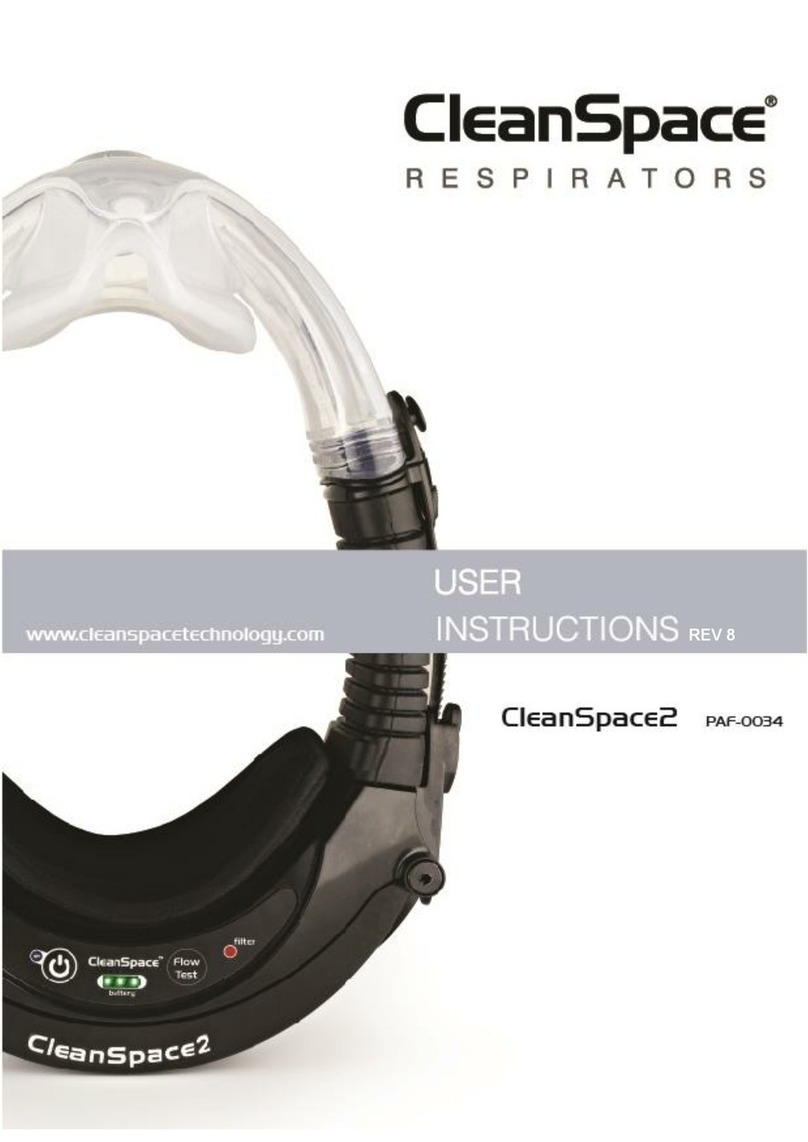
CleanSpace
CleanSpace CleanSpace2 Installation instructions
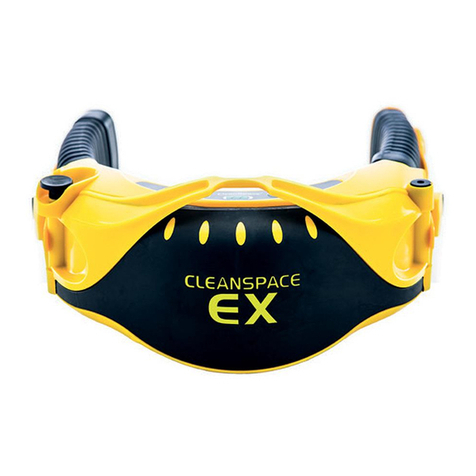
CleanSpace
CleanSpace EX User manual
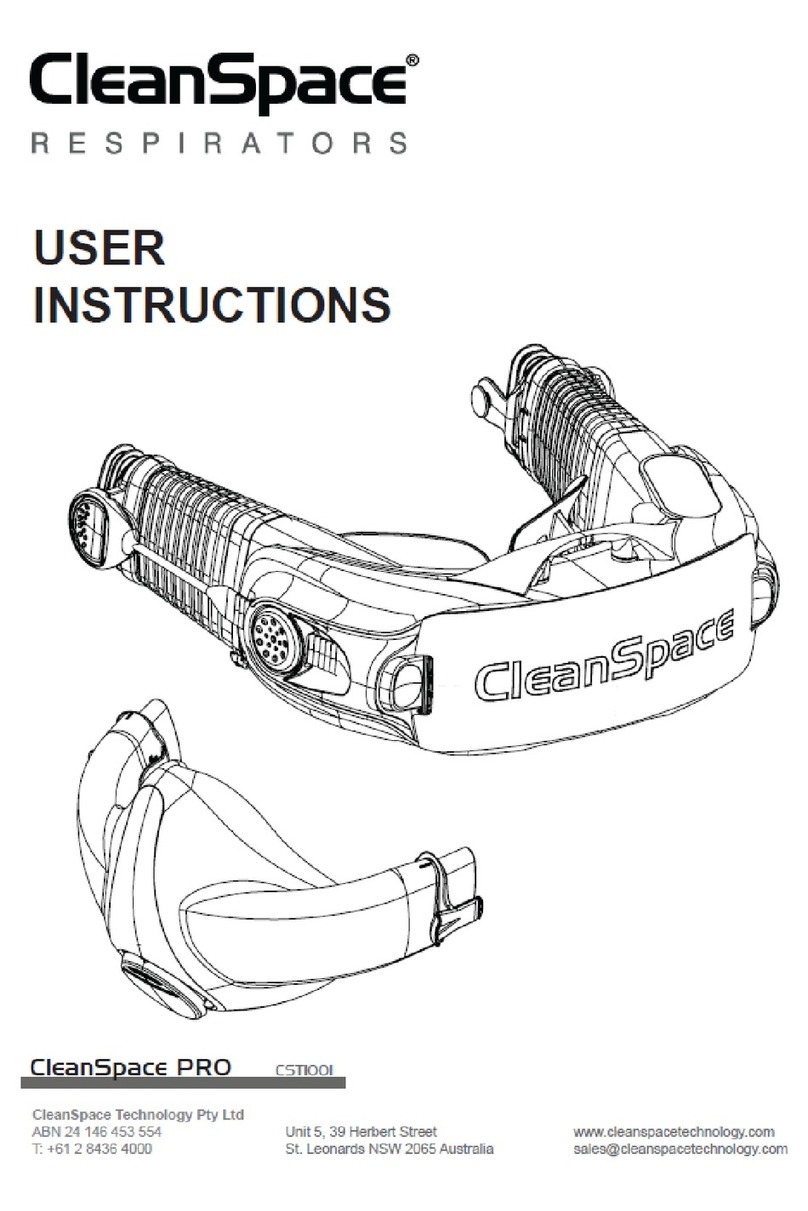
CleanSpace
CleanSpace PRO User manual

CleanSpace
CleanSpace HALO User manual

CleanSpace
CleanSpace HALO CS3021 with BIO-HOOD User manual
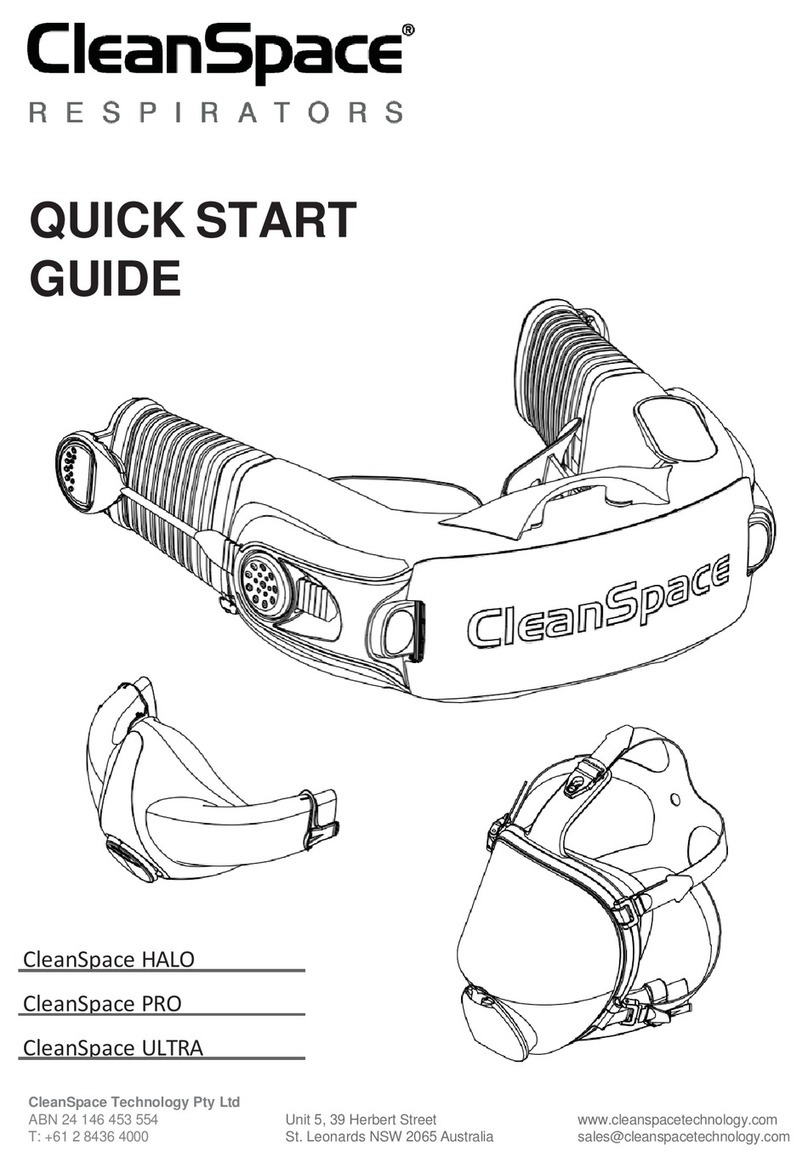
CleanSpace
CleanSpace HALO User manual

CleanSpace
CleanSpace CleanSpace2 User manual
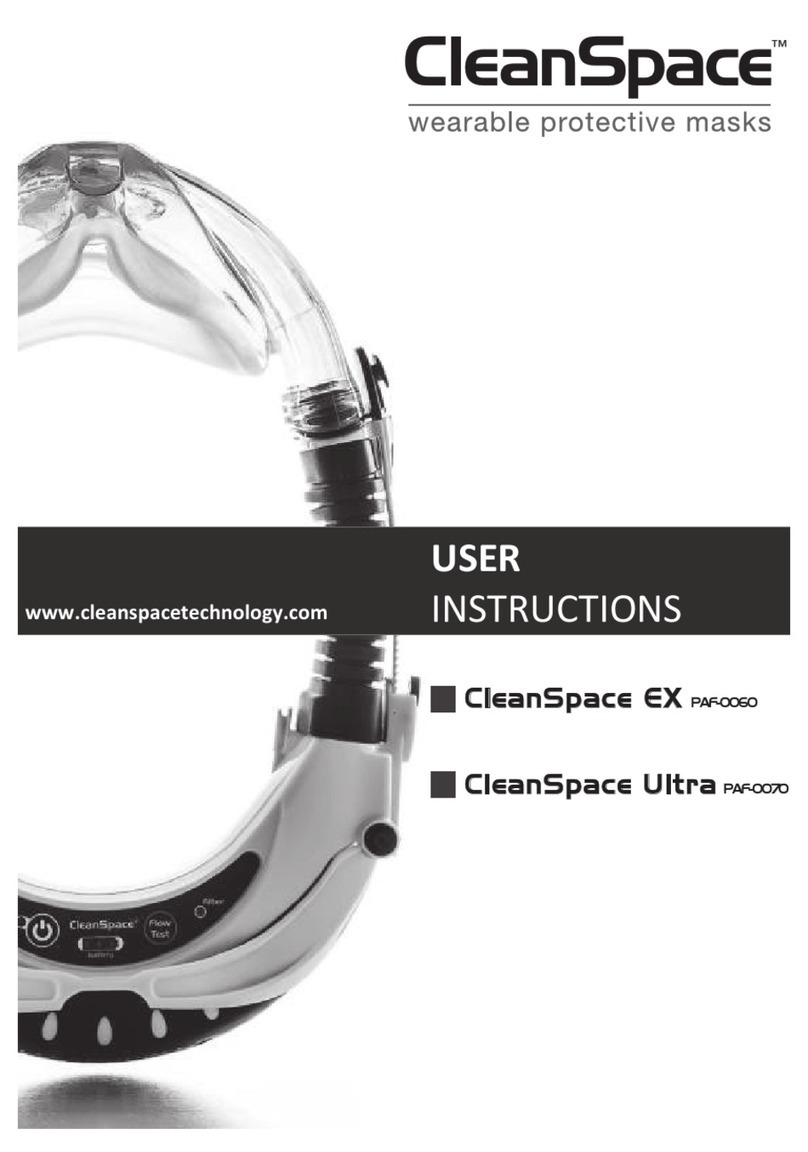
CleanSpace
CleanSpace PAF-0060 User manual
